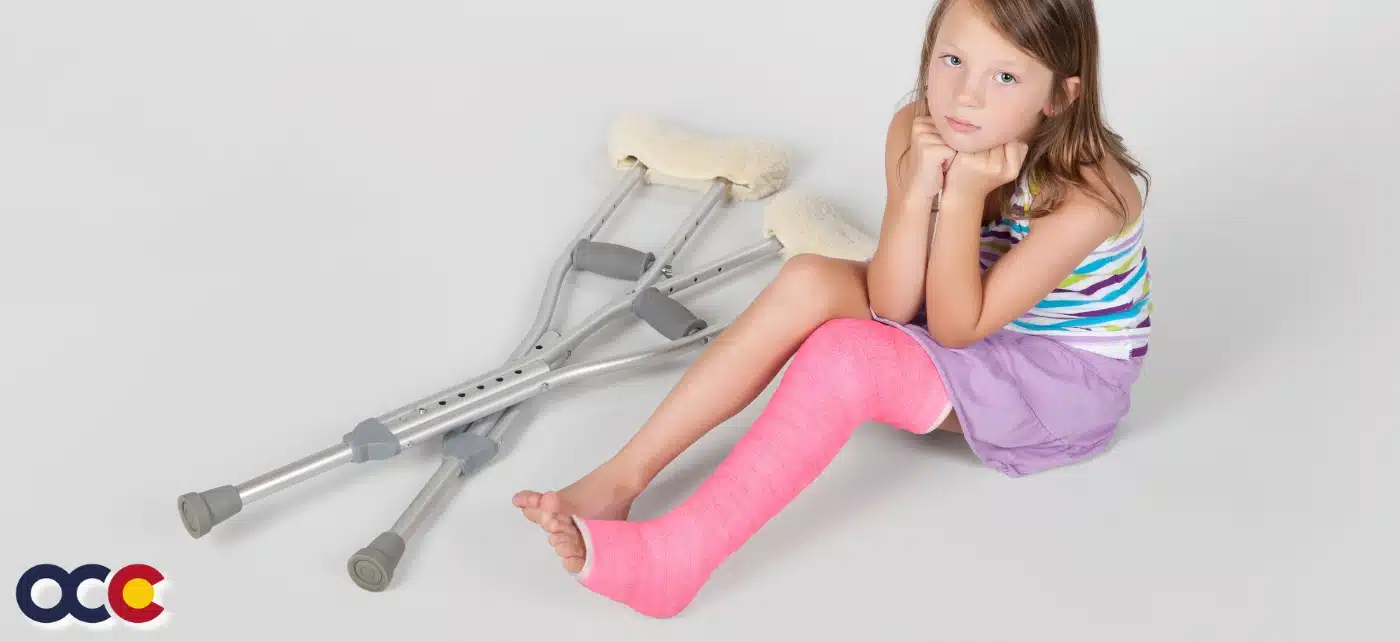Most people don’t know what their tibia is or even where it is located. What is important to know is that the tibia is a weight-bearing bone and plays a crucial role in supporting the body’s weight during activities like standing and walking. Tibia shaft fractures are not only painful, but they may prevent you from moving your leg or putting any weight on it. This can have a serious impact on your life, and that is why you should see a specialized orthopedic surgeon as soon as possible at OCC – Advanced Orthopedic & Sports Medicine Specialists in Denver, Parker, or Aurora, Colorado. Untreated tibia shaft fractures can have serious consequences.
OVERVIEW
The lower leg has two bones in it: the tibia and the fibula. The tibia is the major bone that serves as the primary support of the leg. The shaft is the middle of that bone, which is why it is commonly referred to as the shin bone. It is the most often fractured long bone in the body. Males have the highest incidence of tibia shaft fractures and present with the highest frequency between the ages of 10 and 20, whereas women have the highest frequency between the ages of 30 and 40. Tibia shaft fractures are a common pediatric fracture. Young children and toddlers are at risk for tibial shaft fractures, even when the force of injury is low. Pediatric tibia shaft fractures are the third most common long bone fracture in children, accounting for 10 to 15 percent of all pediatric fractures. Tibia shaft fractures in children under six, are often called “toddler’s fracture”. They are most common in children in the early years of walking – 9 months to 3 years. A toddler’s fracture is a spiral fracture of the tibia without any injury to the fibula.
ABOUT THE TIBIA
The tibia is one of the two long bones in the lower leg, with the other being the fibula. The shaft of the tibia refers to the long, cylindrical portion of the bone between the proximal (near the knee) and distal (near the ankle) ends. It is also known as the diaphysis. It is closer to the inside of the body (medial) than the fibula or smaller lower leg bone. The tibia is the second longest bone in the body and the most commonly fractured long bone in the body. It is a vital part of the knee and ankle joints. It must heal straight to allow these joints to work well. Many important muscles also attach to this bone, which helps the thigh, leg, and foot muscles work properly. The shaft of the tibia includes the anterior border, posterior surface, soleal line, and lateral border.
WHAT IS A TIBIA SHAFT FRACTURE?
Tibia shaft fractures vary greatly, depending on the force that causes the break. Tibia shaft fractures can be:
- Nondisplaced: a fracture where the broken bones remain aligned. This type of fracture is usually seen in children under four.
- Displaced, noncomminuted: a fracture where the bones are broken in no more than two pieces (noncomminuted) but are not aligned. This is an isolated fracture of the tibia shaft with an intact fibula. It is the most common tibia shaft fracture.
- Displaced, comminuted: a fracture where the bones are broken in several fragments and not aligned.
Many doctors describe tibia shaft fractures using classification systems depending on the following:
- The location of the fracture (the tibial shaft is divided into thirds: distal, middle, and proximal)
- The pattern of the fracture (for example, the bone can break in different directions, such as crosswise, lengthwise, or in the middle)
- If the skin around the fracture is intact (closed fracture)
- Whether a bone breaks in such a way that bone fragments stick out through the skin or a wound penetrates down to the broken bone. This type of fracture is called an open or compound fracture. Open fractures often involve much more damage to the surrounding muscles, tendons, and ligaments. They have a higher risk for complications—especially infections—and take a longer time to heal.
CAUSES
Tibia shaft fractures can result from a wide variety of mechanisms. They can be described as low-energy caused by twisting or falls from standing height. This is frequently seen in older patients, as the tibia, like all bones, can be affected by osteoporosis. Sports injuries, such as a fall while skiing, football, rugby, or running into another player during soccer, are lower-energy injuries that can cause tibia shaft fractures. Tibia shaft fractures considered high-energy are often caused by high levels of force, such as a car accident or a fall from a long distance. Common causes of toddler fractures are twisting the leg while walking or running or sliding down a slide and getting the foot caught, resulting in a twist. This is more common if a child is sitting on an older child’s or adult’s lap while going down a slide.
SYMPTOMS
Symptoms will vary depending on the type, location, and severity of the break. Commonly, symptoms will include:
- A limp
- Inability to walk or bear weight on the leg
- Severe pain
- Swelling
- Instability of the leg
- Uneven leg lengths
- Bone “tenting” over the skin at the fracture sight
- Occasional loss of feeling in the foot
- Bruising or discoloration (may indicate damage to blood vessels)
- Abnormal alignment or positioning of the foot on the affected side
NON-SURGICAL TREATMENTS
Non-surgical treatments for tibia shaft fractures are generally considered for stable fractures. Some common non-surgical treatments include:
- Immobilization with a splint or cast
- Traction that involves applying a pulling force to the affected limb to align and stabilize the fractured bones
- Functional bracing allows limited movement of the knee and ankle while providing stability to the fracture site
- Physical therapy to maintain joint mobility, prevent muscle atrophy, and promote overall recovery
- Follow-up X-rays and monitoring to watch the progress of healing and make any treatment changes
- Anti-inflammatory medications (NSAIDS)
- Analgesics
- Immunoglobulins
- Antibiotics and tetanus may be required for open fractures
WHEN IS SURGERY INDICATED?
Surgeons may recommend an operation to fix the broken tibia if the fracture is extremely unstable because of many bone fragments and large degrees of displacement, if it is an open fracture and the bone sticks out of the skin, or if the skin is at risk of dying. Surgery will also be recommended when non-surgical methods have failed.
GETTING THE RIGHT DIAGNOSIS. GETTING THE RIGHT DOCTOR.
After a detailed medical history and thorough examination, your surgeon will most likely order imaging tests such as X-rays and CT scans, which can provide your surgeon with valuable information about the type of fracture, its severity, and where it is located. In every case, it is important to choose your surgeon wisely. Extensive surgical experience and skill are key to achieving a good result and avoiding complications. The orthopedic surgeons at Advanced Orthopedics in Denver, Parker, or Aurora, Colorado, collectively take pride in outstanding surgical results. They also understand that an important part of treatment is understanding what you are going through. That’s why they are there for you in every way possible from the onset of your injury until the time you are back on your feet and enjoying life. If you have been injured and may have fractured your tibia, schedule an appointment today.














